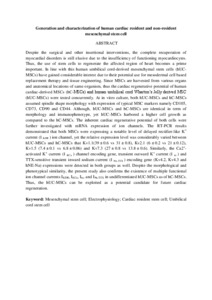Citation
Subramani, Baskar and Subbannagounder, Sellamuthu and Palanivel, Sekar and Ramanathanpullai, Chithra and Sivalingam, Sivakumar and Yakub, Azhari and SadanandaRao, Manjunath and Seenichamy, Arivudainambi and Pandurangan, Ashok Kumar and Tan, Jun Jie and Ramasamy, Rajesh
(2016)
Generation and characterization of human cardiac resident and non-resident mesenchymal stem cell.
Cytotechnology, 68 (5).
pp. 2061-2073.
ISSN 0920-9069; ESSN: 1573-0778
Abstract
Despite the surgical and other insertional interventions, the complete recuperation of myocardial disorders is still elusive due to the insufficiency of functioning myocardiocytes. Thus, the use of stem cells to regenerate the affected region of heart becomes a prime important. In line with this human umbilical cord-derived mesenchymal stem cells (hUC-MSCs) have gained considerable interest due to their potential use for mesodermal cell based replacement therapy and tissue engineering. Since MSCs are harvested from various organs and anatomical locations of same organism, thus the cardiac regenerative potential of human cardiac-derived MSCs (hC-MSCs) and human umbilical cord Wharton’s Jelly derived MSC (hUC-MSCs) were tested concurrently. At in vitro culture, both hUC-MSCs and hC-MSCs assumed spindle shape morphology with expression of typical MSC markers namely CD105, CD73, CD90 and CD44. Although, hUC-MSCs and hC-MSCs are identical in term of morphology and immunophenotype, yet hUC-MSCs harbored a higher cell growth as compared to the hC-MSCs. The inherent cardiac regenerative potential of both cells were further investigated with mRNA expression of ion channels. The RT-PCR results demonstrated that both MSCs were expressing a notable level of delayed rectifier-like K+ current (I KDR ) ion channel, yet the relative expression level was considerably varied between hUC-MSCs and hC-MSCs that Kv1.1(39 ± 0.6 vs 31 ± 0.8), Kv2.1 (6 ± 0.2 vs 21 ± 0.12), Kv1.5 (7.4 ± 0.1 vs 6.8 ± 0.06) and Kv7.3 (27 ± 0.8 vs 13.8 ± 0.6). Similarly, the Ca2+-activated K+ current (I KCa ) channel encoding gene, transient outward K+ current (I to ) and TTX-sensitive transient inward sodium current (I Na.TTX ) encoding gene (Kv4.2, Kv4.3 and hNE-Na) expressions were detected in both groups as well. Despite the morphological and phenotypical similarity, the present study also confirms the existence of multiple functional ion channel currents IKDR, IKCa, Ito, and INa.TTX in undifferentiated hUC-MSCs as of hC-MSCs. Thus, the hUC-MSCs can be exploited as a potential candidate for future cardiac regeneration.
Download File
![[img]](http://psasir.upm.edu.my/54374/1.hassmallThumbnailVersion/Generation%20and%20characterization%20of%20human%20cardiac%20resident%20and%20non-resident%20mesenchymal%20stem%20cell.pdf)  Preview |
|
Text
Generation and characterization of human cardiac resident and non-resident mesenchymal stem cell.pdf
Download (77kB)
| Preview
|
|
Additional Metadata
Actions (login required)
 |
View Item |

